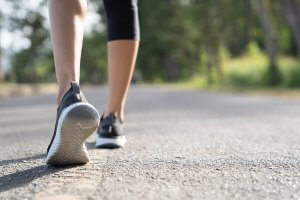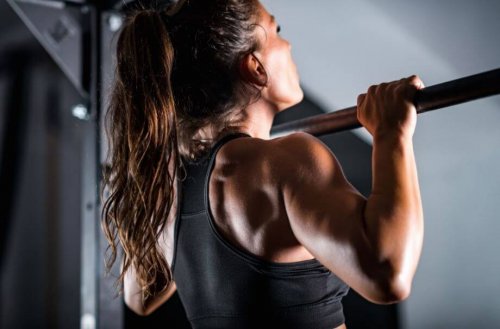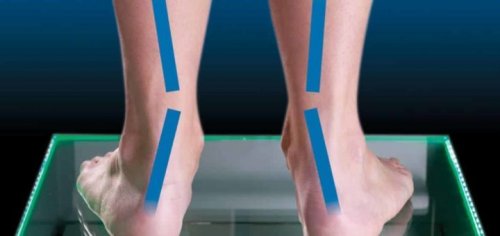What is Pronation?

A person who regularly attends the gym will know that certain movements can be made with a “prone” or “supine” grip. Likewise, runners understand the importance of knowing if their footprint has pronation or supination. Today, considering both situations, we’ll explain what pronation is.
Pronation is the inward turn that the forearm makes so that the back of the hand is facing up and the palm ends up facing the opposite direction.
Nonetheless, we also refer to it as pronation when the foot turns inward when we walk. Let’s see what each one consists of in detail.
Forearm pronation
As we mentioned before, we perform forearm pronation when we rotate the forearm so that the back of the hand faces up. This type of pronation is particularly important in regular sports practice in gyms and in activities such as weightlifting.
- Pull-ups are a classic way to work on the dorsals and they’re usually done with this grip. This is how we achieve greater isolation in our back workouts; unlike chin-ups, which also involve the arms.
- The deadlift is an essential exercise in any training routine and it’s best to do it with a prone grip. Adept lifters use both grips (one hand with a pronation grip and the other with a supine grip).
- Olympic lifters or weightlifters should enhance this type of grip. To improve it even more, they use the hook grip in which the index and middle fingers clamp the thumb with a prone grip.
- Some variants of the classic bicep curl use a pronation grip for greater activation of the forearm muscles.

With so many alternatives, it’s advisable to try some exercises with a pronation variant the next time you attend the gym. This can cause a new stimulus and a greater development of accessory muscles, which will improve your performance.
Pronation of the foot
Foot pronation is the inward turning movement that our feet make when we walk or run. There’s a certain degree of physiological supination taking place when we set our foot on a surface. On the contrary, when we lift the foot, a slight pronation occurs which is absolutely normal.
We must worry when the pronation is excessive. In this situation, our body will take compensatory postures that can lead to injuries.
There are certain types of footwear with cushioning that can fix this problem. This type of footwear helps runners to balance their footprint so that it’s more neutral; this way, they’ll avoid possible injuries.
Nonetheless, we must confront this issue with great caution as there are commercial interests regarding brands of shoes. Often, buying special footwear is something that’ll only be advisable for overpronators. That is people with a high degree of pronation that’s pathological. A pronator runner can wear neutral footwear without any worries.
Overpronation
As we already mentioned, excessive pronation while walking is pathological and can lead to several injuries. These types of walkers stroll with flat feet since excessive internal rotation causes the foot to tread with inadequate areas and acquire this shape.

Overpronation can be caused by some injuries, weakness in the surrounding muscles, or even by the use of inappropriate footwear. The problem is also frequently due to genetic or simply postural origins, which include poor walking techniques.
Since this overpronation creates instability in the joints, overpronator patients may also complain about pain in their back and knees.
This happens because both knees and the spine work harder to provide the stability that’s lacking. Additionally, applying more pressure on ligaments, tendons, and ankle bones may cause injuries such as plantar fasciitis and calcaneal spurs.
The treatment of these patients will be the use of special footwear or cushion insoles. Overpronators will have to visit a physiotherapist who’ll indicate certain strengthening exercises and teach them to correct their footprint.
A person who regularly attends the gym will know that certain movements can be made with a “prone” or “supine” grip. Likewise, runners understand the importance of knowing if their footprint has pronation or supination. Today, considering both situations, we’ll explain what pronation is.
Pronation is the inward turn that the forearm makes so that the back of the hand is facing up and the palm ends up facing the opposite direction.
Nonetheless, we also refer to it as pronation when the foot turns inward when we walk. Let’s see what each one consists of in detail.
Forearm pronation
As we mentioned before, we perform forearm pronation when we rotate the forearm so that the back of the hand faces up. This type of pronation is particularly important in regular sports practice in gyms and in activities such as weightlifting.
- Pull-ups are a classic way to work on the dorsals and they’re usually done with this grip. This is how we achieve greater isolation in our back workouts; unlike chin-ups, which also involve the arms.
- The deadlift is an essential exercise in any training routine and it’s best to do it with a prone grip. Adept lifters use both grips (one hand with a pronation grip and the other with a supine grip).
- Olympic lifters or weightlifters should enhance this type of grip. To improve it even more, they use the hook grip in which the index and middle fingers clamp the thumb with a prone grip.
- Some variants of the classic bicep curl use a pronation grip for greater activation of the forearm muscles.

With so many alternatives, it’s advisable to try some exercises with a pronation variant the next time you attend the gym. This can cause a new stimulus and a greater development of accessory muscles, which will improve your performance.
Pronation of the foot
Foot pronation is the inward turning movement that our feet make when we walk or run. There’s a certain degree of physiological supination taking place when we set our foot on a surface. On the contrary, when we lift the foot, a slight pronation occurs which is absolutely normal.
We must worry when the pronation is excessive. In this situation, our body will take compensatory postures that can lead to injuries.
There are certain types of footwear with cushioning that can fix this problem. This type of footwear helps runners to balance their footprint so that it’s more neutral; this way, they’ll avoid possible injuries.
Nonetheless, we must confront this issue with great caution as there are commercial interests regarding brands of shoes. Often, buying special footwear is something that’ll only be advisable for overpronators. That is people with a high degree of pronation that’s pathological. A pronator runner can wear neutral footwear without any worries.
Overpronation
As we already mentioned, excessive pronation while walking is pathological and can lead to several injuries. These types of walkers stroll with flat feet since excessive internal rotation causes the foot to tread with inadequate areas and acquire this shape.

Overpronation can be caused by some injuries, weakness in the surrounding muscles, or even by the use of inappropriate footwear. The problem is also frequently due to genetic or simply postural origins, which include poor walking techniques.
Since this overpronation creates instability in the joints, overpronator patients may also complain about pain in their back and knees.
This happens because both knees and the spine work harder to provide the stability that’s lacking. Additionally, applying more pressure on ligaments, tendons, and ankle bones may cause injuries such as plantar fasciitis and calcaneal spurs.
The treatment of these patients will be the use of special footwear or cushion insoles. Overpronators will have to visit a physiotherapist who’ll indicate certain strengthening exercises and teach them to correct their footprint.
All cited sources were thoroughly reviewed by our team to ensure their quality, reliability, currency, and validity. The bibliography of this article was considered reliable and of academic or scientific accuracy.
- Qué es la sobrepronación – Causas y Tratamientos. [cited 2019 Mar 17]; Available from: https://www.terapiadefrio.com/blogs/terapia-de-frio-calor-tratamiento-natural-de-lesiones/sobrepronacion-casusas-tratamientos
- Horwood AM, Chockalingam N. Defining excessive, over, or hyper-pronation: A quandary. Foot [Internet]. 2017 Jun [cited 2019 Mar 17];31:49–55. Available from: http://www.ncbi.nlm.nih.gov/pubmed/28549281
- Hintermann B, Nigg BM. Pronation in Runners. Sport Med [Internet]. 1998, Sep. [cited 2019 Mar 17];26(3):169–76. Available from: http://www.ncbi.nlm.nih.gov/pubmed/9802173
This text is provided for informational purposes only and does not replace consultation with a professional. If in doubt, consult your specialist.








